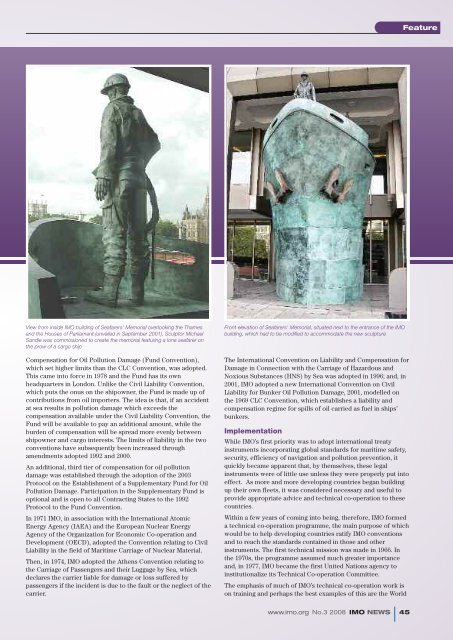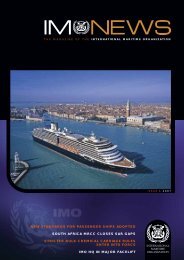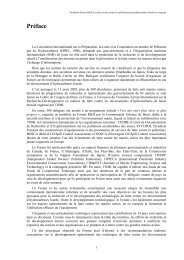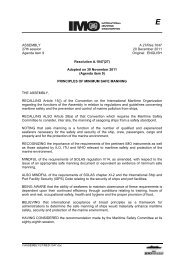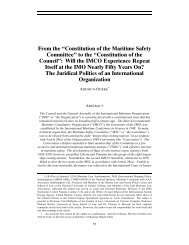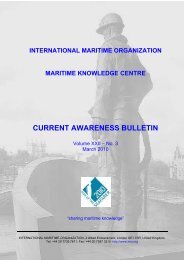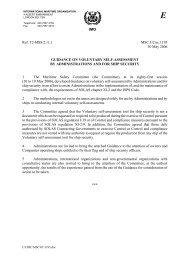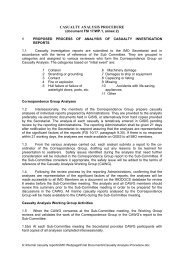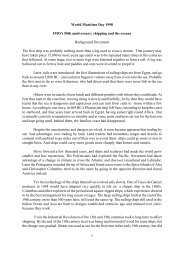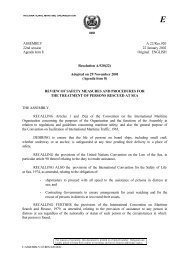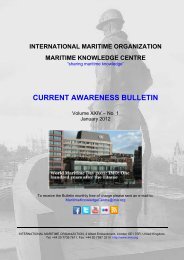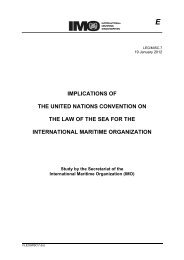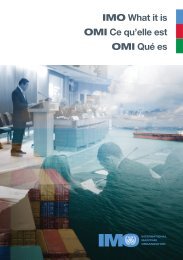IMO News
IMO News
IMO News
Create successful ePaper yourself
Turn your PDF publications into a flip-book with our unique Google optimized e-Paper software.
Feature<br />
View from inside <strong>IMO</strong> building of Seafarers’ Memorial overlooking the Thames<br />
and the Houses of Parliament (unveiled in September 2001). Sculptor Michael<br />
Sandle was commissioned to create the memorial featuring a lone seafarer on<br />
the prow of a cargo ship<br />
Compensation for Oil Pollution Damage (Fund Convention),<br />
which set higher limits than the CLC Convention, was adopted.<br />
This came into force in 1978 and the Fund has its own<br />
headquarters in London. Unlike the Civil Liability Convention,<br />
which puts the onus on the shipowner, the Fund is made up of<br />
contributions from oil importers. The idea is that, if an accident<br />
at sea results in pollution damage which exceeds the<br />
compensation available under the Civil Liability Convention, the<br />
Fund will be available to pay an additional amount, while the<br />
burden of compensation will be spread more evenly between<br />
shipowner and cargo interests. The limits of liability in the two<br />
conventions have subsequently been increased through<br />
amendments adopted 1992 and 2000.<br />
An additional, third tier of compensation for oil pollution<br />
damage was established through the adoption of the 2003<br />
Protocol on the Establishment of a Supplementary Fund for Oil<br />
Pollution Damage. Participation in the Supplementary Fund is<br />
optional and is open to all Contracting States to the 1992<br />
Protocol to the Fund Convention.<br />
In 1971 <strong>IMO</strong>, in association with the International Atomic<br />
Energy Agency (IAEA) and the European Nuclear Energy<br />
Agency of the Organization for Economic Co-operation and<br />
Development (OECD), adopted the Convention relating to Civil<br />
Liability in the field of Maritime Carriage of Nuclear Material.<br />
Then, in 1974, <strong>IMO</strong> adopted the Athens Convention relating to<br />
the Carriage of Passengers and their Luggage by Sea, which<br />
declares the carrier liable for damage or loss suffered by<br />
passengers if the incident is due to the fault or the neglect of the<br />
carrier.<br />
Front elevation of Seafarers’ Memorial, situated next to the entrance of the <strong>IMO</strong><br />
building, which had to be modified to accommodate the new sculpture<br />
The International Convention on Liability and Compensation for<br />
Damage in Connection with the Carriage of Hazardous and<br />
Noxious Substances (HNS) by Sea was adopted in 1996; and, in<br />
2001, <strong>IMO</strong> adopted a new International Convention on Civil<br />
Liability for Bunker Oil Pollution Damage, 2001, modelled on<br />
the 1969 CLC Convention, which establishes a liability and<br />
compensation regime for spills of oil carried as fuel in ships’<br />
bunkers.<br />
Implementation<br />
While <strong>IMO</strong>’s first priority was to adopt international treaty<br />
instruments incorporating global standards for maritime safety,<br />
security, efficiency of navigation and pollution prevention, it<br />
quickly became apparent that, by themselves, these legal<br />
instruments were of little use unless they were properly put into<br />
effect. As more and more developing countries began building<br />
up their own fleets, it was considered necessary and useful to<br />
provide appropriate advice and technical co-operation to these<br />
countries.<br />
Within a few years of coming into being, therefore, <strong>IMO</strong> formed<br />
a technical co-operation programme, the main purpose of which<br />
would be to help developing countries ratify <strong>IMO</strong> conventions<br />
and to reach the standards contained in those and other<br />
instruments. The first technical mission was made in 1966. In<br />
the 1970s, the programme assumed much greater importance<br />
and, in 1977, <strong>IMO</strong> became the first United Nations agency to<br />
institutionalize its Technical Co-operation Committee.<br />
The emphasis of much of <strong>IMO</strong>’s technical co-operation work is<br />
on training and perhaps the best examples of this are the World<br />
www.imo.org No.3 2008 <strong>IMO</strong> NEWS 45


